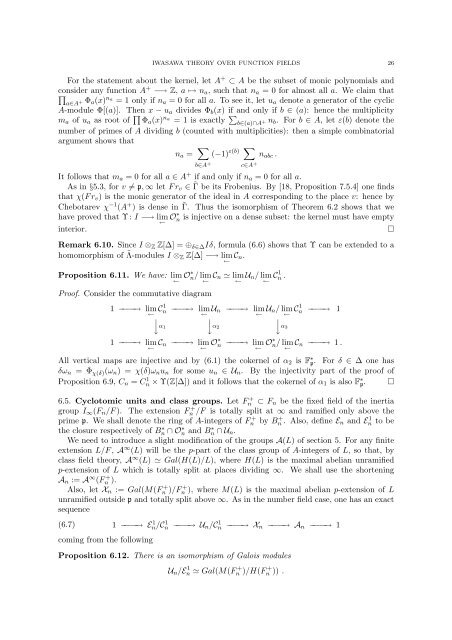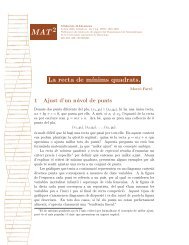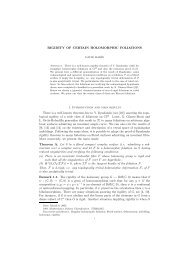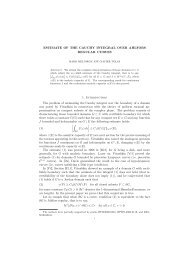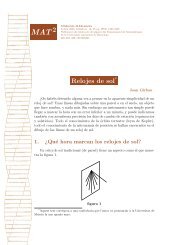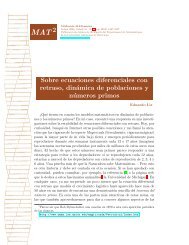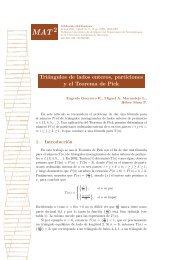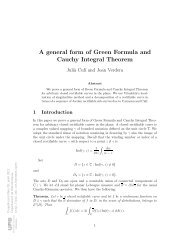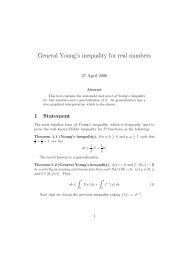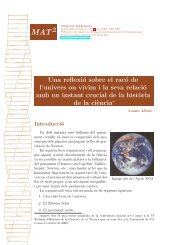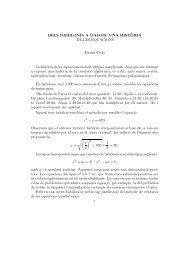ASPECTS OF IWASAWA THEORY OVER FUNCTION FIELDS 1 ...
ASPECTS OF IWASAWA THEORY OVER FUNCTION FIELDS 1 ...
ASPECTS OF IWASAWA THEORY OVER FUNCTION FIELDS 1 ...
You also want an ePaper? Increase the reach of your titles
YUMPU automatically turns print PDFs into web optimized ePapers that Google loves.
<strong>IWASAWA</strong> <strong>THEORY</strong> <strong>OVER</strong> <strong>FUNCTION</strong> <strong>FIELDS</strong> 26For the statement about the kernel, let A + ⊂ A be the subset of monic polynomials andconsider∏any function A + −→ Z, a ↦→ n a , such that n a = 0 for almost all a. We claim thata∈A + Φ a(x) n a= 1 only if n a = 0 for all a. To see it, let u a denote a generator of the cyclicA-module Φ[(a)]. Then x − u a divides Φ b (x) if and only if b ∈ (a): hence the multiplicitym a of u a as root of ∏ Φ a (x) na = 1 is exactly ∑ b∈(a)∩A + n b. For b ∈ A, let ε(b) denote thenumber of primes of A dividing b (counted with multiplicities): then a simple combinatorialargument shows thatn a = ∑(−1) ∑ ε(b) n abc .b∈A + c∈A +It follows that m a = 0 for all a ∈ A + if and only if n a = 0 for all a.As in §5.3, for v ≠ p, ∞ let F r v ∈ ˜Γ be its Frobenius. By [18, Proposition 7.5.4] one findsthat χ(F r v ) is the monic generator of the ideal in A corresponding to the place v: hence byChebotarev χ −1 (A + ) is dense in ˜Γ. Thus the isomorphism of Theorem 6.2 shows that wehave proved that Υ: I −→ lim←O ∗ n is injective on a dense subset: the kernel must have emptyinterior.Remark 6.10. Since I ⊗ Z Z[∆] = ⊕ δ∈∆ Iδ, formula (6.6) shows that Υ can be extended to ahomomorphism of ˜Λ-modules I ⊗ Z Z[∆] −→ lim←C n .Proposition 6.11. We have: lim←O ∗ n/ lim←C n ≃ lim←U n / lim←C 1 n .Proof. Consider the commutative diagram1 −−−−→ lim C 1←n −−−−→ lim U n −−−−→ lim U n / lim C 1← ← ←n −−−−→ 1⏐↓ α ⏐1 ↓ α ⏐2↓ α 31 −−−−→ lim←C n −−−−→ lim←O ∗ n −−−−→ lim←O ∗ n/ lim←C n −−−−→ 1 .All vertical maps are injective and by (6.1) the cokernel of α 2 is F ∗ p. For δ ∈ ∆ one hasδω n = Φ χ(δ) (ω n ) = χ(δ)ω n u n for some u n ∈ U n . By the injectivity part of the proof ofProposition 6.9, C n = Cn 1 × Υ(Z[∆]) and it follows that the cokernel of α 1 is also F ∗ p. □6.5. Cyclotomic units and class groups. Let F n + ⊂ F n be the fixed field of the inertiagroup I ∞ (F n /F ). The extension F n + /F is totally split at ∞ and ramified only above theprime p. We shall denote the ring of A-integers of F n+ by B n + . Also, define E n and En 1 to bethe closure respectively of Bn ∗ ∩ On ∗ and Bn ∗ ∩ U n .We need to introduce a slight modification of the groups A(L) of section 5. For any finiteextension L/F , A ∞ (L) will be the p-part of the class group of A-integers of L, so that, byclass field theory, A ∞ (L) ≃ Gal(H(L)/L), where H(L) is the maximal abelian unramifiedp-extension of L which is totally split at places dividing ∞. We shall use the shorteningA n := A ∞ (F n + ).Also, let X n := Gal(M(F n + )/F n + ), where M(L) is the maximal abelian p-extension of Lunramified outside p and totally split above ∞. As in the number field case, one has an exactsequence(6.7) 1 −−−−→ E 1 n/C 1 n −−−−→ U n /C 1 n −−−−→ X n −−−−→ A n −−−−→ 1coming from the followingProposition 6.12. There is an isomorphism of Galois modulesU n /E 1 n ≃ Gal(M(F + n )/H(F + n )) .□


